With many utility companies left in the dark as to what is happening on their electric network, Erik Christian shares his views on what an agile and modern energy grid should look like.
It has been estimated by the U.S. Energy Information Administration that disruption to business continuity, caused by power outages and interruptions, cost as much as $150 billion a year. To reduce this burden, and to help our grid cope with the demands of today’s digital economy, urgent modernization of the electricity network is required. In the same way our internet infrastructure is evolving to manage increasing amounts of data, so must our aging electric grid infrastructure evolve if it is to handle current and future demand.
In today’s digital world it’s hard to believe that millions of miles of electric distribution lines remain, for the most part, unmonitored, leaving many utilities blind beyond the substation and occasionally, quite literally in the dark.
The U.S author and award-winning engineer Dr. H James Harrington said: “If you can’t measure something, you can’t understand it. If you can’t understand it, you can’t control it. If you can’t control it, you can’t improve it.”
At Tollgrade, we provide utilities and network operators better situational awareness, giving them real-time actionable intelligence on the status of their grid, and the ability to foresee and take action in situations that may lead to power outages in the future.
Over the last few decades, significant investment spurred improvements to the transmission and low-voltage areas of the energy sector. However, underinvestment in the distribution network continues to leave many areas of the grid vulnerable to faults.
Bridging the gap
An increasing everyday reliance on consumer technology and the growing penetration of renewable energy as a generation resource are just a few of the factors contributing to the pressure utilities feel to modernize their aging grid infrastructure. Today’s distribution network is where 90 percent of outages occur, and according to an IEEE report, a significant contributor is failing equipment, which cause roughly 30 percent of all overhead power distribution outages. Grid operators lack adequate visibility of events on their network, forcing operators to react to problems on the grid rather than taking a proactive or predictive approach to equipment maintenance and outages.
Bridging the gap between yesterday’s network and the grid of the future will require utilities to deploy solutions capable of not only solving today’s aging grid challenges, but also evolve with the growing needs of the industry, while being sensitive to the associated costs. These solutions will need to be over-the air upgradeable, adaptable to future challenges without costing utilities valuable truck rolls and operating dollars to upgrade their monitoring system.
While the 20th century grid was focused on quickly solving issues as they arise, the grid of the 21st century will need to be more dynamic, identifying and fixing underlying precursors before they actually cause an outage or failure. To that end, some utilities and network operators throughout the U.S. and Europe have positioned themselves to be ahead of the game. These utilities now have the ability to analyze, detect and diagnose precursors to network faults, ensuring the actual fault never occurs. With a next-generation distribution monitoring platform, it’s now realistic to foresee a time when there are no unplanned outages on the grid whatsoever.
Lighting the way forward
Today, more than 35 utilities across three continents, including DTE Energy, Toronto Hydro, Manitoba Hydro and Veridian Connections are using Tollgrade’s platform to gain real-time information in the battle to predict and prevent power outages and equipment failures.
As we integrate more forms of generation from renewable energy sources like wind and solar into the distribution grid, UK distribution network operators (DNOs), including Western Power Distribution, Scottish and Southern Energy Power Distribution, and Scottish Power selected LightHouse to advance critical applications, including network planning, capacity monitoring, and active network management. As European countries continue to move toward a low carbon network with bi-directional power flow, having accurate real-time voltage and current measurements will be an essential requirement to monitor their network, ensure grid safety and speed the integration of renewable energy.
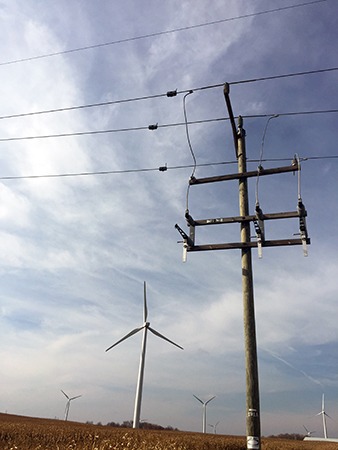
Smart grid sensors supporting integration of renewable energy
The canary in the coal mine – Waveform analysis
Many solutions exist today to give grid operators valuable data on the health of their network. Raw data, however, isn’t enough in the fight to end power outages. To truly understand what’s happening on their network, operators must have access to analytics software that leverages waveform analysis and pattern recognition to elevate data into actionable intelligence.
Capturing fault waveform data is crucial as it helps distribution engineers identify unusual, recurring events or power quality issues.
Traditional monitoring methods don’t capture and scrutinize waveforms and tend only to alert utilities to malfunctioning assets well after, or in some cases not at all. Waveform analysis enables patterns of data to be identified as specific events. A powerful monitoring system should be able to distinguish hazardous from non-hazardous events. Repeated warnings of hazardous events often indicate problems with a failing asset, allowing engineers to be dispatched, make the necessary repairs and prevent a major outage.
One example of how predictive analytics can help utility companies keep the lights on is the work being carried out by Tollgrade and Detroit-based DTE Energy, as part of their commitment to ‘Build a Predictive Grid for the Motor City’ for the Clinton Global Initiative. The companies were able to identify and verify a category of events, called line disturbances, that act as an early indicator to outages. Line disturbance events are absolutely critical to establishing a predictive grid.
Line disturbances are nearly impossible for traditional monitoring solutions to identify and are more pervasive than one might expect in a utility’s network. The published Predictive Grid Analytics Reports reveal that 84 percent of events captured on DTE’s network were classified as line disturbances. Trending analysis verifies the correlation between line disturbances and outages, and monitoring line disturbances as a precursor to outages should become an industry standard.
Predictive grid in action
Although the evolution to a truly dynamic, predictive grid will take time, utilities deploying smart grid sensors are beginning to experience their full benefit today. A large investor owned utility in the northeastern United Sates provides a great real world example. This utility had only deployed smart grid sensors for a few months when they began receiving notifications of line disturbances on their 34.5kV network from LightHouse software. Over the course of several hours, an increasing amount of line disturbance events were detected in the same area of their grid. The data captured by the smart grid sensors provided line engineers with the exact location of the future fault. This saved the utility valuable time by avoiding having to patrol an entire 20-mile section of their power grid in the dark.

LightHouse fault waveform capture
(click to enlarge)
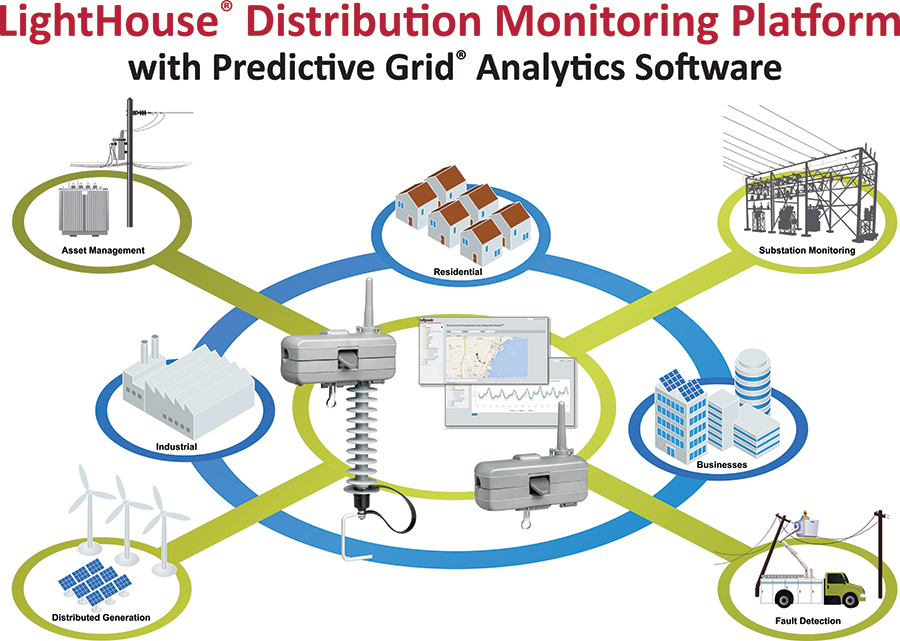
LightHouse distribution monitoring platform
(click to enlarge)
In this situation, traditional monitoring solutions weren’t able to detect the issue. These precursor events went undetected by substation relays and SCADA devices, which of course failed to notify network operators of the impending situation.
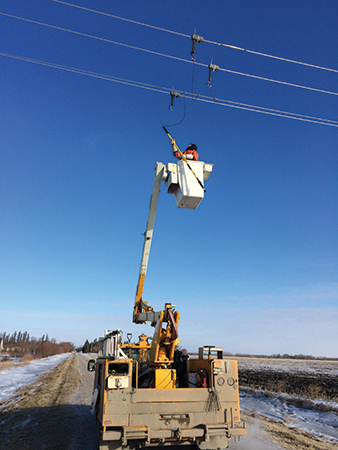
Lighthouse MV Power Sensor installation
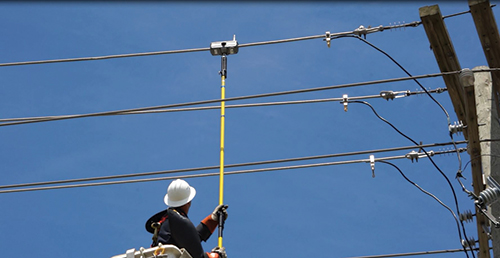
Hot stick installation of smart grid line sensor
Smart grid sensors directed distribution engineers to a substation, where they discovered a serious problem with a voltage regulator that was experiencing internal arcing and about to blow. The faulty equipment was quickly isolated and repaired. Had the voltage regulator ruptured, over 2,000 customers would have lost power for several hours causing an estimated 360,000 Customer Minutes Interrupted (CMI). A ruptured voltage regulator would also have caused a serious environmental and safety issue, with over 80 gallons of oil spilling out and polluting the immediate vicinity.
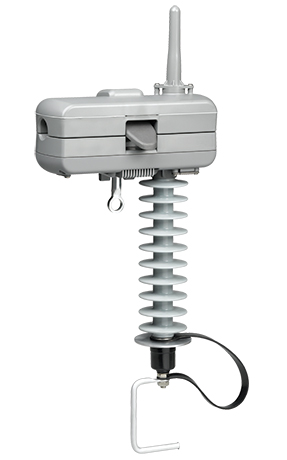
MV Power Sensor
Summary
Power outages and interruptions are a financial drain on our economy. New industry challenges, like renewable energy generation, are expected to significantly stress our aging distribution network over the next few decades.
The future of the grid, whether it’s an extension of the Internet of Things (IoT) movement or some other paradigm, will mandate an expansive real-time monitoring platform capable of spotting issues before they occur. As highlighted in the latest Grid Modernization Index report issued by the GridWise Alliance, utilities need to quickly move away from a ‘data starved’ environment. How do utilities gain much needed visibility today, knowing that so much will change over coming years? They do so by investing in a software defined, over-the-air upgradeable solution capable of growing and evolving to solve future applications.
The best monitoring platforms contain affordable smart grid sensors, which in a single form factor combine highly accurate measurement tools and waveform capture, and analytics software capable of predicting outages and events before they occur. In this type of solution, utilities will finally find an ally in their quest to bridge the gap between yesterday’s reactive grid and tomorrow’s grid of the future.
About the Author
 As Vice President of Smart Grid, Erik Christian is responsible for Tollgrade’s go-to-market strategy for smart grid in all key markets including North America, Latin America and Europe and drives marketing, product direction, business development and sales engineering. Prior to Tollgrade, Erik worked as an Investment Banker at Oppenhiemer & Co. and CIBC World Markets in New York City, specializing in Technology, Media and Telecommunications mergers and acquisitions, equity offerings and debt financing and at Columbia Capital, a Washington DC venture capital firm.
As Vice President of Smart Grid, Erik Christian is responsible for Tollgrade’s go-to-market strategy for smart grid in all key markets including North America, Latin America and Europe and drives marketing, product direction, business development and sales engineering. Prior to Tollgrade, Erik worked as an Investment Banker at Oppenhiemer & Co. and CIBC World Markets in New York City, specializing in Technology, Media and Telecommunications mergers and acquisitions, equity offerings and debt financing and at Columbia Capital, a Washington DC venture capital firm.
Erik received his Bachelor of Science in Finance and International Business from the Pennsylvania State University.







